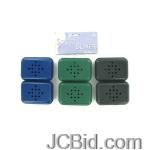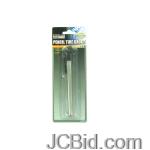
| Updated Blogs |
|
Computer Support Blog
Essensial Software for Web Based Support
HP Server and Desktop
HP ILO - Remote Tech-Support Software
More .....
|
 RSS Feed | Login
RSS Feed | Login http://www.fr-batterie-portable.com
http://www.fr-batterie-portable.com/dell.html
Battery for Compaq Presario CQ61z
By Zdziarski at 2017-09-10 23:26:15
School pupils in Powys could win vouchers for their school if they can recycle as many batteries as they can.
Powys County Council is running a free battery recycling competition and is urging schools to sign up to be in with a chance of winning vouchers.
The school which collects the most batteries per pupil could win a share of £500 worth of Amazon vouchers. The competition is being sponsored by the European Recycling Platform, the council’s compliance scheme for waste electrical and electronic equipment and batteries.Schools who sign up will be provided with a free battery box and will compete over the autumn term to collect as many domestic batteries as possible. This includes the standard AA and AAA nickel cadmium batteries, button cell batteries, power packs from tools and mobile phone and laptop batteries.
Councillor Phyl Davies, the council’s Cabinet Member for Waste and Recycling, said: “This is a fantastic competition I would urge every school in the county to take part.
“Batteries are made from recyclable metals including lead, cadmium, zinc, lithium and mercury. Each battery collected by a school can be re-melted and used to make new batteries rather than going to landfill where they could cause soil and water pollution.
“By taking part, schools could win vouchers and they will also help the county meet recycling targets, cut landfill and carbon emissions and inspire the next generation to recycle more.”
Safety procedures for implantable and wearable batteries normally necessitate structural fortification for avoiding the leakage of dangerous chemicals. As an alternative, the research team headed by Wang and Huisheng Peng, a Macromolecular Science Professor, substituted the flammable and hazardous liquids with inexpensive and environment-friendly sodium-ion blends. Of these blends, two were biocompatible and appropriate for implantable devices, as they were not known to cause any harm to the interior or surface of the human body.
- Battery for HP Compaq NC6120
- Battery for HP Compaq 9400
- Battery for HP Compaq 8700
- Battery for HP Compaq 8510w
- Battery for HP Compaq 7400
- Battery for HP Compaq 6735b
- Battery for HP Compaq 6715s
- Battery for HP Compaq 6510b
- Battery for HP 4320t
While leakage of electrolyte is nevertheless considered to be unfavorable, the risk caused by the leakage can be reduced by using either the normal IV saline solution administered into human body during treatment or a cell-culture medium comprising vitamins, sugars, and amino acids along with sodium ions, and hence simulates the fluid surrounding human cells.
As the research team was now freed from worries of leakage that mandate the usage of protective material which make batteries unbendable and heavy, they engineered two kinds of flexible batteries. One was a two-dimensional “belt” shaped battery in which thin electrode films were affixed to a steel strand net. The other was a one-dimensional fiber-shaped battery in which a carbon nanotube backbone was surrounded by nanoparticles of electrode material. Apart from investigating biocompatible liquids, the Researchers also investigated the use of normal sodium sulfate (a reasonably inert and safe blend) as a fluid electrolyte in external wearable devices.
Related Stories
Market Outlook on Biomass Power in India
Electronics Breakthrough Could Lead to Powerful Electronics That Consume Less Energy
LG Electronics Expands Electronics Recycling Program To Cover All 50 States of the US
Upon using sodium sulfate blend as the electrolyte, the performance of both the belt-shaped and fiber-shaped batteries was higher than the previously used wearable lithium-ion batteries with regards to charge-retaining potential, or the time period for which a battery can operate without being recharged, and power yield relative to the size of the batteries. This potential was still found to be good when the batteries were folded and bent to simulate the effect of wearing a watch, sensor, or similar gadgets around a person’s arm.Charge-retaining potential was only slightly minimized for both the cell-culture-based and saline-solution-based batteries, perhaps because the sodium-ion content in these batteries was marginally lesser than the sodium sulfate solution.
An undesired side effect in the fiber-shaped battery has given the research team ideas for probable biomedical usage. Carbon nanotubes similar to the ones that form the skeleton of the one-dimensional battery have the ability to speed up the transformation of dissolved oxygen into hydroxide ions. This process that has a negative impact on the battery capacity when ignored can enhance therapeutic potential for the treatment of bacterial infections and cancer when applied as a stand-alone process.
- Battery for Compaq Presario CQ72
- Battery for Compaq Presario CQ71
- Battery for Compaq Presario CQ70
- Battery for Compaq Presario CQ62
- Battery for Compaq Presario CQ61z
- Battery for Compaq Presario CQ61
- Battery for Compaq Presario CQ60z
- Battery for Compaq Presario CQ60
- Battery for Compaq Presario CQ56
- Battery for Compaq Presario CQ50
- Battery for Compaq Presario CQ35
- www.all-laptopbattery.com/hp.html
The electric vehicle and energy storage markets are undergoing huge shifts that are reorienting the graphite industry, particularly in the natural graphite market, says a new BCC Research report. BCC Research estimates electrical applications to achieve the highest CAGR (24.7%) among all application segments of the global graphite market, from 2016-2021. This torrid growth is catalyzed by the lithium-ion battery segment, which is projected to grow at a 31.0% CAGR to reach a value of $1.7 billion in 2021, up from $369 million in 2015. Overall, the global market for graphite is expected to grow at a 7.7% CAGR.
Graphite: Technologies and Global Markets reports that electrical conductivity properties are ushering in a large new market for graphite in the field of energy storage applications. Green energies such as wind and solar markets are stoking big demand for energy storage requirements, in terms of batteries. Additionally, cell phones and other electronic equipment require power and energy storage devices. Among all battery technologies, lithium-ion battery technology excels for its ability to store large quantities of power in limited space while quickly powering devices and equipment. These batteries use a large quantity of graphite, often between 30 grams and 40 grams of graphite for each gram of lithium used.
Permalink | Comments (0)
Comments
To add a comment please login by clicking here




